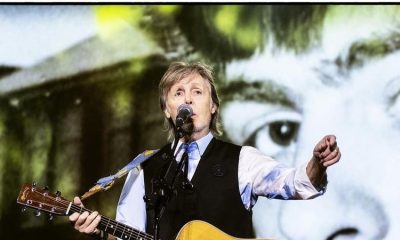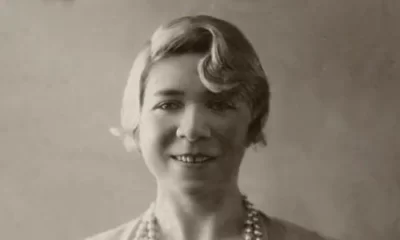Art
John Ruskin

John Ruskin Biography
John Ruskin (February 8, 1819 – January 20, 1900) writer, painter, art critic, and reformer. He was born in London, England. His parents were Margaret Cox and John James Ruskin, a rich merchant who instilled in him a passion for art, literature, and adventure. He studied at the University of Oxford. In 1837, he entered the University of Oxford. Then, he founded a drawing school for students: the Company of St George, for social improvement, useful arts, and the defense of an ornamentalism linked to the reform of society.
He received socialist influences, especially from the group of “Sheffield socialists,” as did William Morris. He advanced a postulate regarding the relationship between art and morals, these dissertations appear in the first volume of Modern Painters (1843), a work that provided an important place among art critics. Later, he published The Seven Lamps of Architecture (1849) and The Stones of Venice (1851-1853), where the moral, economic and political importance of architecture were analyzed. In 1851 he became interested in pre-Raphaelist painters such as Dante Rossetti, Edward Burne-Jones, and John Everett Millais.
His ideas denounce the aesthetic numbness and the pernicious social effects of the Industrial Revolution. His work at Oxford ended in the rejection of the vivisection practices carried out in the laboratories of that institution. After marrying Effie Gray, he published Conferences on architecture and painting (1854), Conferences on the political economy of art (1858) and Fors Clavigera (1871-1884).
Ruskin suffered some psychiatric episodes and little by little he lost the sense of reality. Finally, he died in Lancashire on January 20, 1900. He aroused the admiration of generations of Victorian artists, especially as an introducer of the neo-Gothic taste in England, the greatest champion of pre-Raphaelism. Currently, part of his works is preserved between drawings of nature and different Gothic cathedrals at the University of Oxford.
WORKS
- Modern painters
- The seven lamps of architecture
- The stones of Venice
- Conferences on architecture and painting
- The political economy of art
- Two ways
- Sesame and lilies
- The morale of dust
- The crown of wild olive
- Fors Clavigera
- The Amiens Bible
- Preterite

Art
Fernando Botero
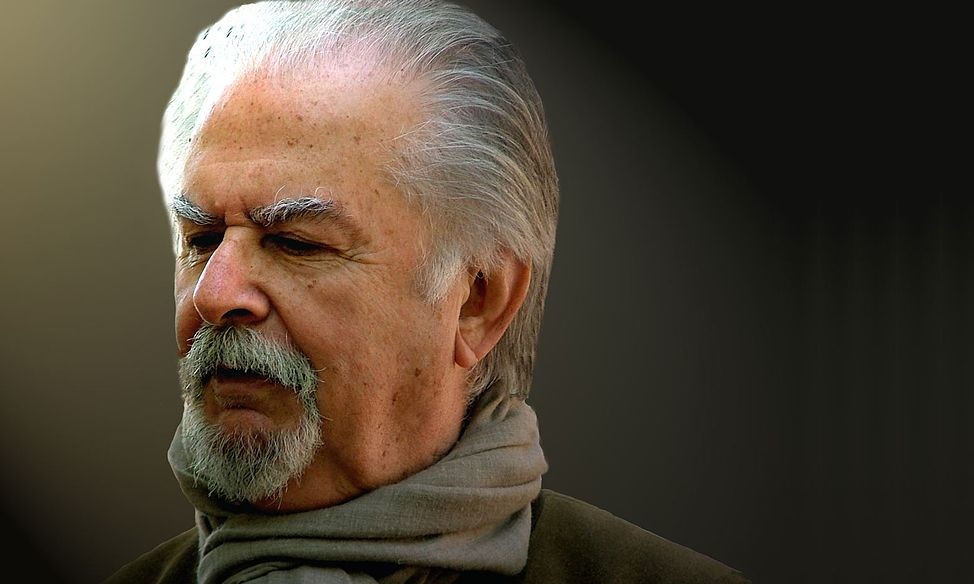
Fernando Botero Biography
Fernando Botero Angulo (April 19, 1932 – September 15, 2023) was a sculptor, painter, muralist, and draftsman, hailing from Medellín, Antioquia, Colombia. He was a Colombian artist known and celebrated for infusing a substantial volume to human and animal figures in his works.
Early Years and Beginnings
Fernando Botero was born into an affluent Paisa family, composed of his parents, David Botero and Flora Angulo, along with his older brother Juan David, who was four years his senior, and his younger brother, Rodrigo, who would be born four years after Fernando, in the same year that their father passed away. In 1938, he enrolled in primary school at the Ateneo Antioqueño and later entered the Bolivariana to continue his high school education. However, he was expelled from the institution due to an article he published in the newspaper El Colombiano about Picasso, as well as his drawings that were considered obscene. As a result, he graduated from high school at the Liceo of the University of Antioquia in 1950.
In parallel to his studies, Fernando attended a bullfighting school in La Macarena at the request of one of his uncles. However, due to an issue related to bullfighting, Botero left the bullring and embarked on a journey into painting. In 1948, he held his first exhibition in Medellín. Two years later, he traveled to Bogotá where he had two more exhibitions and had the opportunity to meet some intellectuals of the time. He then stayed at Isolina García’s boarding house in Tolú, which he paid for by painting a mural. Once again in Bogotá, he won the second prize at the IX National Artists Salon with his oil painting “Facing the Sea”.
“Ephemeral art is a lesser form of expression that cannot be compared to the concept of art conceived with the desire for perpetuity. What many people fail to understand is that Picasso is a traditional artist”- Fernando Botero
Due to the prize from the IX Salon and the sale of several of his works, Fernando Botero traveled to Spain in 1952 to enroll at the Royal Academy of Fine Arts of San Fernando in Madrid. There, he lived by selling drawings and paintings in the vicinity of the Prado Museum. In 1953, he went to Paris with filmmaker Ricardo Irrigarri, and later, they both traveled to Florence. Here, he entered the Academy of San Marco, where he was heavily influenced by Renaissance painters such as Piero della Francesca, Titian, and Paolo Uccello.
Career and Personal Life
In 1955, Botero returned to Colombia to hold an exhibition featuring several of his works created during his time in Europe, but it was met with a lukewarm reception from the public.
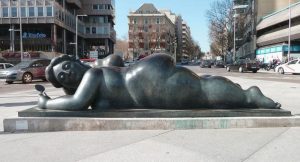
Woman With a Mirror / Foto:Luis García (Zaqarbal) / Attribution-ShareAlike 3.0 Spain (CC BY-SA 3.0 ES)
In 1956, he married Gloria Zea, with whom he would later have three children: Fernando, Juan Carlos, and Lina. The couple traveled to Mexico City, where Fernando Botero was eager to see the works of Mexican muralists, but this experience left him disillusioned. Consequently, he began searching for his own artistic style, drawing influence from both the Mexican artist Rufino Tamayo and the Colombian artist Alejandro Obregón. In this quest, he started experimenting with volume, initially in still lifes, and gradually extending this approach to other elements.
In 1957, he successfully exhibited in New York, showcasing his new artistic sensibility. The following year, he returned to Bogotá, where he was appointed as a professor at the School of Fine Arts at the National University of Colombia. He presented his work “La Camera Degli Sposi” at the X Colombian Artists Salon, winning the first prize and becoming the country’s most prominent painter. This piece sparked some controversy as it was initially censored for being almost a parody of Andrea Mantegna’s “La Cámara de los Esposos”. However, it was later reinstated in the exhibition on the advice of Marta Traba. Subsequently, Fernando Botero exhibited his works in various spaces in the United States, where a businessman from Chicago purchased “La Camera Degli Sposi”.
“Fernando Botero and his works are the finest ambassadors of our country in this land of navigators and discoverers, of poets and fado singers”- Juan Manuel Santos
In 1960, Botero separated from Gloria Zea and traveled to New York. He led a modest life here as the New York art scene was primarily inclined towards abstract expressionism. Consequently, Botero was influenced by artists like Pollock, which led him to experiment with color, brushwork, and format, to the point of nearly abandoning his distinctive style characterized by the manipulation of volume. Aware of this, Botero returned to his usual style of flat colors and figurative representations.
Starting in 1962, he began a series of exhibitions in both Europe and the United States, as well as in Colombia. By 1970, the year his son Pedro was born to his second wife, Cecilia Zambrano, Fernando Botero had already become the world’s most sought-after sculptor. However, in 1974, his son Pedro tragically died in a traffic accident, leading to his second divorce and leaving significant marks on his artistic endeavors.
In 1978, the Colombian painter married Sophia Vari, a renowned Greek artist with whom he shared a significant part of his life, until sadly, she passed away in May 2023.
Since 1983, Fernando Botero has been exhibiting his works and donating them to various cities around the world. As a result, we can find his pieces in the streets of Medellín, Barcelona, Oviedo, Singapore, and Madrid, among others. In 2008, the Autonomous University of Nuevo León in Mexico conferred upon him an honorary Doctorate.
Death
Renowned Colombian artist, Fernando Botero, died on September 15, 2023, in Monaco at the age of 91 due to pneumonia. His artistic legacy will endure forever. In his hometown, seven days of mourning were declared.

Pedrito a Caballo, Fernando Botero (1975).
Top 10 Famous works by Fernando Botero
Some of the most recognized works by Colombian painter and sculptor Fernando Botero:
- “Pedrito on Horseback” / “Pedrito a Caballo” (1974): This is an oil painting on canvas measuring 194.5 cm x 150.5 cm. For Botero, this work is his masterpiece and a refuge during a personal tragedy. The child depicted is Pedro, his son from his second marriage, who tragically passed away in an accident when he was young.
- “Mona Lisa at 12 Years Old” / “Mona lisa a los 12 años” (1978): This piece stands out as a unique version of Leonardo da Vinci’s famous painting, the Mona Lisa. Painted in oil on canvas and measuring 183 cm x 166 cm, Botero incorporates his characteristic style of voluptuous and rounded figures into this work, which has become one of his most distinctive pieces.
- “Woman’s Torso” / “Torso de Mujer” (1986): It is a majestic bronze sculpture that rises to an impressive height of approximately 2.48 meters. It is often affectionately referred to as “La Gorda” (“The Fat One”). This artwork finds its home in Parque de Berrío, located in the captivating city of Medellín.
- “Woman with Mirror” / “Mujer con Espejo” (1987): An imposing bronze sculpture weighing 1000 kg. It is located in Plaza de Colón, in the heart of Madrid, Spain. The artwork captivates the gaze with the portrayal of a woman peacefully lying face down on the ground, holding a mirror in her hands. Her expression reflects deep introspection and enigmatic melancholy.
- “The Orchestra” / “La Orquesta” (1991): In this oil on canvas artwork, measuring 200 cm x 172 cm, Botero presents a band of musicians with a singer, all immersed in a spirit of celebration. The artist aims to convey a sense of harmony and joy through his portrayal.
- “Woman Smoking” / “Mujer Fumando” (1994): It is a creation executed in watercolor, spanning dimensions of 122 cm x 99 cm. In this work, Maestro Botero skillfully captures the essence of a woman elegantly holding a cigarette between her fingers. His meticulous focus on voluptuous forms, posture, and the serene expression of the figure masterfully combine to emphasize the sensuality and profound intimacy of the moment captured in the artwork.
- “Man on Horseback” / “Hombre a Caballo” (1996): This bronze sculpture is one of the most iconic works in the artist’s career. It depicts a rider in a majestic and proud posture. Over the years, this imposing work has been exhibited in multiple cities around the world, solidifying its place as a prominent piece in the sculptor’s body of work.
- “The Horse” / “El Caballo” (1997): This iconic sculpture showcases a horse of majestic presence and a distinctive rounded form, sculpted in bronze and measuring approximately 3 meters in height. This masterpiece reflects Botero’s profound passion for horses while also serving as a powerful representation of the mythical Trojan Horse.
- “The Death of Pablo Escobar” / “La muerte de Pablo Escobar” (1999): This artwork, created using the oil on canvas technique, has dimensions of 58 cm x 38 cm. While not considered a masterpiece, this artistic piece represents one of the most significant moments in Colombia’s history. Fernando Botero captures, in his distinctive style, the moment of the death of the drug lord Pablo Escobar, addressing issues related to violence and criminality that have marked the country’s history.
An interesting detail is that, although Pablo Escobar admired Fernando Botero’s art, it cannot be said that the admiration was mutual. The painter created two works depicting the death of the drug trafficker. - “Boterosutra Series” / “Serie Boterosutra” (2011): This work by Botero is part of an erotic art collection called Boterosutra, marking a milestone in the history of Colombian art as the first artistic representation of sexual intimacy between lovers. This series comprises around 70 small-sized pieces created using various techniques, including colored drawings, watercolors, brushstrokes, and also black and white, all of which constitute one of the most contemporary works by the painter.
Art
Gustave Courbet
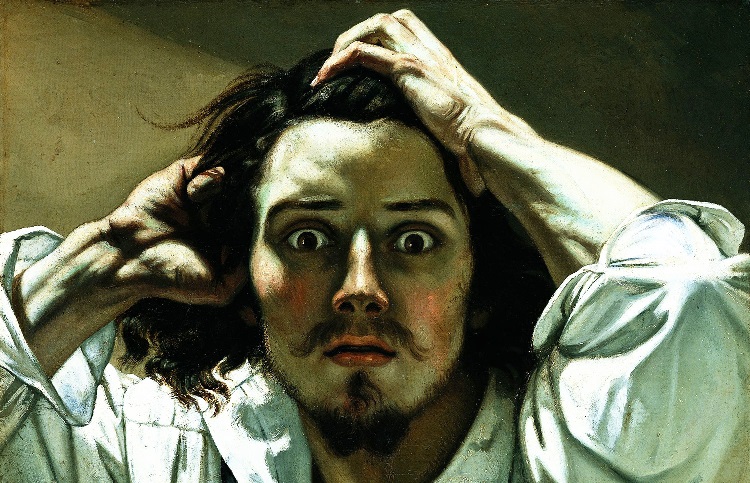
Biography of Gustave Courbet
Gustave Courbet, Jean Désiré Gustave Courbet (1819-1877) was a painter. Courbet was born in the French town of Ornans. His parents and family were landowners in Ornans. Courbet was influenced by his parents to study law, but his true passion was drawing. Therefore, while studying law, he began drawing under the tutelage of a student named Flajoulot. When he turned 20, he withdrew from his law studies and moved to Paris to complete his artistic training with the teachings of Steuben, Bonvin, and Père Baud, a student of Gros. There he became interested in the works of Chardin, the Le Nain brothers, and the Spanish painters Ribera, Zurbarán, Murillo, and Velázquez.
Based in Paris since 1839, he delved into the Realist painting trend of the 19th century. He studied at the Swiss Academy and extensively analyzed the works of some artists from the Flemish, Venetian, and Dutch schools of the 16th and 17th centuries. He achieved artistic maturity when he discovered the works of Rembrandt on a trip he took to the Netherlands in 1847. From then on, works such as L’après diner a Ornans (1849), El entierro en Ornans (1849) or Los paisanos de Flagey volviendo del campo (1850) emerged, where the characters are represented with all their vulgarity or a compromising sensuality.
Courbet’s works caused a stir and controversy because the public was faced with a new realistic vision of everyday events. Additionally, his style as a revolutionary and provocative man, follower of the anarchist philosophy of Proudhon, and participant in the 1871 Paris Commune, led to his imprisonment for six months, until he sought refuge in Switzerland in 1873. All of this scandalized the public, who often criticized him but also admired him. His self-portraits were based on Romanticism. In 1846, he wrote a manifesto against Romantic and neoclassical tendencies with Bouchon. Courbet’s realism was a protest against the sterile academic painting and exotic motifs of Romanticism. He focused on the revolutionary environments of the 19th century.
He traveled to Holland to study the works of Hals and Rembrandt and participated indirectly in the military uprising. During this period, two of his most important realist works were created: The Burial at Ornans and The Stone Breakers, this work was lost due to World War II. Courbet’s paintings elicited all types of comments due to their realistic portrayal of the lives of ordinary people. After the coup d’etat of Louis Napoleon Bonaparte in 1852, the painter returned to his hometown.
While there, Courbet opened his own exhibition titled “Realism.” It was born as a protest against the rejection of his works at the Paris Universal Exhibition in 1855. The central work was the enormous painting: “The Painter’s Studio” (1855). It was presented as a “realistic allegory.” Later, other figure and portrait paintings emerged: “Ladies by the Seine” (1857), the self-portrait “The Cellist” (1849) and “The Beautiful Irishwoman” (1866). The artist also created works related to the sea, landscapes of forests and mountains with their fauna, flowers and still lifes.
Courbet became a representative of the emerging realism of the time. Courbet was described as a conceited man, who claimed to be the most handsome and seductive of humans, due to his Assyrian profile, he boasted of his ability to illuminate new forms of truth and beauty to end the outdated trends of Paris. For this reason, we can understand why he was such a controversial painter and was often hated. Nevertheless, the magnificent works that this painter conceived during his life could not be denied.
Let’s return to The Burial at Ornans (1849), it is his work of greatest dimensions and complexity, he wanted to bring a huge fragment of rural reality from his land to the refined environment of Paris. This composition can be seen as disordered and with little hierarchy. Courbet manages to make the viewer sit at the same level as the villagers of Ornans and symbolically attend the funeral of a humble peasant. In addition, the diversity of individual expressions tries to make a critical description and a study of the social categories of a population. This work is admired for its formal and coloristic stylization, and its horizontal composition.
Another great work of this French painter is Bonjour, monsieur Courbet (1854). The painting shows in great detail the local environment, as well as the light and characters, reflecting a real event with great objectivity. This painting has become a kind of standard-bearer of realistic art for many artists in recent decades. Courbet broke the mold with the work Señoritas a orillas del Sena (1857), because the Parisian public was used to paintings on mythological or historical themes; on the contrary, in Courbet’s canvas, the two women represented in showy clothes are two prostitutes resting by the river.
Also impressive was the way it was painted, in opposition to the tastes and rules of the time; the thick brushstrokes, the color tones and the disregard for the canons of beauty. In that work both the composition and the color, want to reflect reality, each of the elements reflect the same importance, transmitting a certain sense of imperceptible objectivity. Courbet showed total uninhibitedness in front of the female sex. A reflection of this is the work The Origin of the World (1866), was made by order of Bey, this was the most transgressive painting of the 19th century.
Other paintings by this French painter include: Self-Portrait with Black Dog (1842), The Desperate Man (1845), The Meeting (1854), The Painter’s Studio (1855), Woman with Parrot (1866), The Trout (1871) among others. These are just a few of the many works that this artist left for posterity and for future generations interested in realistic art. Courbet’s radical stance, reflected in the realm of politics, specifically with the Paris Commune, led to him being accused of participating in the demolition of the Vendôme Column. He had to go into exile in 1875 in Switzerland, where he died two years later in solitude and poverty.
Art
Anime history

Anime history
Japanese anime or animation emerged at the beginning of the 20th century influenced by animation and the world of cinema developed in the United States, later it was modified and claimed Japanese culture. The anime-style as we know it began to develop in the late 1950s, when the production company Toei Studios and the different series based on short sleeves or cartoons, such as Tetsuwan Atomu, also known as Astro Boy. From the 1980s and 1990s, the anime became popular, appearing large cult series such as Dragon Ball, Neon Genesis Evangelion, Sailor Moon, Detective Conan, Rurouni Kenshin, and Cowboy Bebop, among others. In the new millennium, the Japanese animated industry has been booming, providing new content every season based on successful manga, light novels, video games, and music.
Beginnings
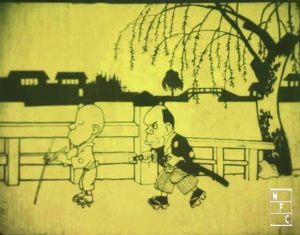
The earliest surviving Japanese animated short made for cinemas, produced in 1917
The first Japanese animations were small short films developed at the end of the 1910s, largely inspired by American animation, in these, folk and comic themes were addressed. The first short film was Namakura Gatana by Junichi Kouchi, it was two minutes long, the story told the story of a man with his katana (Japanese sword or saber). In the following decade, the duration of the short films was extended to ten or fifteen minutes, in which typical oriental tales were represented. Among the pioneer artists of this era are Oten Shimokawa, Junichi Kouchi, Seitaro Kitayama and Sanae Yamamoto; by this time the short film Obasuteyama (The Mountain Where Old Women Are Abandoned) by Yamamoto was published.
During the 30s and 40s, the Japanese animated industry went through a series of changes, the stories were neglected and western stories were taken into account. A short time later the anime Norakuro (1934) of Mituyo Seo, one of the first animations based on a manga. Since then this became a frequent practice. By the end of the 1930s, World War II broke out, a warlike confrontation in which Japan was involved as a member of the Axis powers, at which time the animations became war propaganda. At the end of the war, the country was occupied by the allied powers led by the United States, which seriously affected the country that was going through a deep economic crisis.
Industry development and international boom
In the course of the crisis, the manga and anime industry became popular in the country, thus establishing the basis for the development of the own animated style that occurred around the middle of the 20th century. It was around this time that Toei Studios, an animation film producer, emerged as one of the key figures in the history of anime. This company was a pioneer in the animation of Japan, provided various productions that allowed the advancement of animation in the country. The company’s first animation was Koneko no rakugaki, a short thirteen-minute film published in 1957. The following decade the company grew by focusing on the development of feature films. Other companies such as Mushi Pro, a producer that made the animation of Tetsuwan Atomu (Astro Boy) by Osamu Tezuka, mangaka and animator, one of the most relevant artists of the Japanese animated industry of the 20th century.
Between the 1960s and 1970s, the anime of robots (mecha) became popular appearing iconic series such as Tetsujin 28-gō and Mazinger Z or Gundam, for this same period the popular Doraemon series (1973), based on the homonymous anime, began to air Fujiko Fujio, a series that tells the story of a cosmic robot cat that has attached to its body a bag from which it subtracts various artifacts which are used in the adventures of Doraemon and his human friend Nobita. In the 1980s and 1990s, Japanese animation boomed internationally, which led to many series beginning to dub into English and Spanish, in these years cult series such as Dragon Ball, based on the manga of Akira Toriyama. Saint Seiya also known as The Knights of the Zodiac, Captain Tsubasa, exported as Super champions; Rurouni Kenshin, known in the west as Samurai X, Neon Genesis Evangelion of Hideaki Anno; Pokémon, Ranma ½, and Sakura Card Captor, among others.
In 2000, the already booming anime is largely massified by the acceptance and the huge fan base that it had acquired at the time, these followers known as otakus, boosted the Japanese animated industry. Since then there have been numerous animated productions that have been distributed worldwide, among the most prominent series of the new millennium are One Piece, Naruto, Bleach, Fullmetal Alchemist, Inuyasha, Yu-Gi-Oh, Rozen Maiden, Kuroshitsuji, and Death Note, all are ace based on sleeves that when becoming successful, allowed the development of the animated series.
At present, any manga that has a large number of followers is very likely to have adapted in an animated series, such as Hunter x Hunter, Pandora Hearts, Ao no Exorcist, Mirai Nikki, Bakuman and Shingeki no Kyojin, among many others, light novels have been adapted that have become popular as Durarara!!, Boku wa Tomodachi ga Sukunai, Sword Art Online, and My Youth Romantic Comedy Is Wrong, As I Expected, among others. In recent years, the Yaoi and Yuri genres have been popularized in which romantic relationships between people of the same sex are addressed, among these series it is possible to rescue Junjō Romantica, Sekaiichi Hatsukoi, No. 6, Aoi Hana, Sasameki Koto and Yagate Kimi ni Naru
At present, the Japanese animated industry produces numerous series, ova, and films per year, becoming one of the strongest industries in the world of animation. Among the most prominent people in this industry is Hayao Miyazaki, founder of Studio Ghibli, a studio where films such as My Neighbor Totoro, The Incredible Vagabond Castle, The Journey of Chihiro, and Ponyo, among others, likewise, stand out in the present, artist Makoto Shinkai, creator of 5 centimeters per second, Hoshi Wo Ou Kodomo, Kotonoha no Niwa and Kimi no Na Wa.
Art
John Harvey McCracken
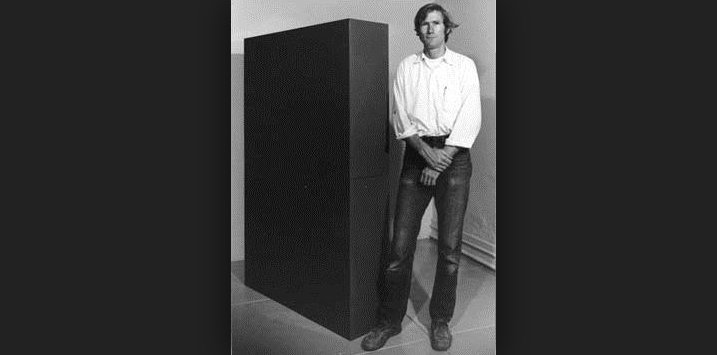
John Harvey McCracken Biography
John Harvey McCracken (December 9, 1934 – April 8, 2011) minimalist artist. He was born in Berkeley, California, United States. He excelled in sculpture and was a reference to the Minimalist Movement. He dedicated four years of his youth to serve in the United States Navy. Subsequently, he entered the California School of Arts and Crafts in Oakland.
Obtaining a BFA in 1962 and completing most of the work for an MFA. Academic life allowed him to meet characters like Gordon Onslow Ford and Tony DeLap. He was hired at several recognized universities where he taught different art subjects, worked at the University of California, School of Visual Arts, University of Nevada, University of California, Santa Barbara, among others.
His first sculptural work was done with the minimalists John Slorp and Peter Schnore, and the painters Tom Nuzum, Vincent Perez, and Terry StJohn. Dennis also known Oppenheim, enrolled in the MFA program at Stanford. He began to experiment with increasingly three-dimensional canvases, McCracken began producing art objects made with industrial techniques and materials such as plywood, spray lacquer, pigmented resin, resulting in striking minimalist works with highly reflective and soft surfaces. He applied similar techniques in the construction of surfboards.
Later, McCracken was part of the Light and Space movement composed by artists such as James Turrell, Peter Alexander, Larry Bell, Robert Irwin, and others. The biggest influences of the art circle were Barnett Newman and the minimalists like Donald Judd, Dan Flavin, and Carl Andre. Thanks to this space, his sculptural work began to walk between the material world and design. He was the first to conceive the idea of the plank. The artist combined aspects of painting and sculpture in his work and many experimented with impersonal and elegant surfaces. In addition to the planks, the artist also created independent wall pieces and sculptures with different shapes and sizes, worked in highly polished stainless steel and bronze.
In McCracken’s work, it is usual to see solid colors in bold with its highly polished finish, it is a way that takes work to another dimension. His palette included pink gum, lemon yellow, deep sapphire and ebony, which he applied as a monochrome. He also made objects of stained wood, highly polished bronze and reflective stainless steel. For several years he relied on Hindu and Buddhist mandalas to make a series of paintings, they were exhibited at Castello di Rivoli in 2011.
His wife was the artist Gail Barringer, she revived to a certain extent her husband’s artistic career, and earned her the recognition of a younger generation of artists, merchants, and curators. Unfortunately, he died on April 8, 2011. Years before, his work had been honored in Documenta 12 in Kassel.
EXHIBITIONS
- “Primary structures” in the Jewish Museum (1966)
- “American sculpture of the sixties” at the Los Angeles County Museum (1967).
- “Inverleith House” at the Royal Botanic Garden Edinburgh (2009)
AUCTION
His top ten auction prices exceed $ 200,000, including his high auction mark for a Black Plank, in polyester resin, fiberglass and plywood, which sold for $ 358,637 at Phillips de Pury & Company London in June 2007. More recently, Flash (2002), a red-board piece of firefighters, sold for $ 290,500 at Christie’s New York in 2010.
WORKS
Nine Planks V, Blue column, Plank, Don’t tell me when to stop, Mykonos, Pyramid, Blue Post and Dintel I, Love in Italian, Right, Blue Post and Dintel, Yellow pyramid, The Absolutely Naked Fragrance, Violet Block in two parties, you won’t know which one until you’ve been to All of Them, Red Plank, Ala (Aile), among others.
Architects
Gian Lorenzo Bernini
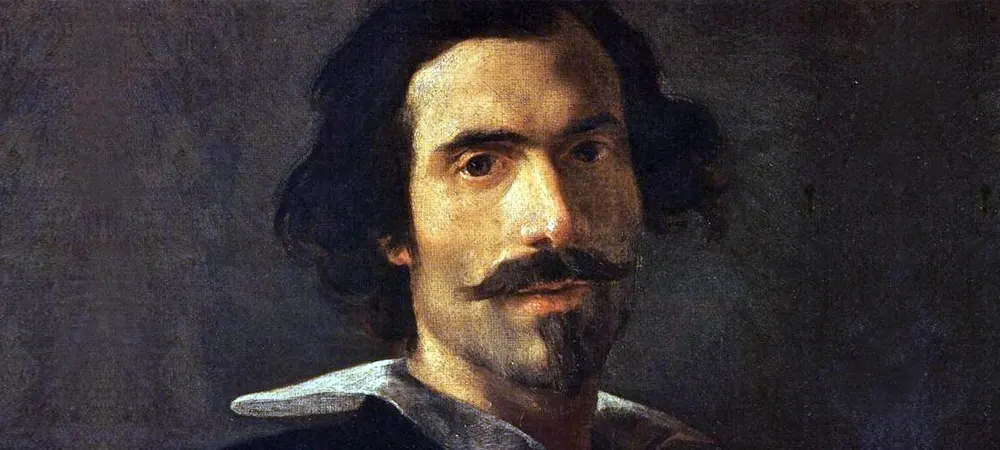
Gian Lorenzo Bernini Biography
Gian Lorenzo Bernini (December 7, 1598 – November 28, 1680) Born in Naples, Italy. Architect, sculptor, and painter, considered one of the most prominent figures of Italian baroque and 17th-century architecture. The renowned Mannerist sculptor Pietro Bernini was trained as an artist in his father’s workshop and subsequently began working with the support of various patrons, including the Borghese family. He began his artistic career in the mid-1610s, with the sculptures San Lorenzo de la Reticle (1614), La Cabra Amaltea (1615) and San Sebastián (1616). He was appointed architect of the basilica of San Pedro in 1629 and since then he worked for various pontiffs and kings. Among his most outstanding works are the monuments: Sepulcher of Urban VIII and Altar of the Blessed Sacrament and the sculptures: Daniel and the lion and Habakkuk and the angel.
FAMILY AND BEGINNINGS
Son of Mannerist sculptor Pietro Bernini and his wife Angelica Galante; Bernini had as brothers Luigi, Dorotea, Eugenia, Agnese, Francesco, Vincenzo, Emiliana, Beatrice, Domenico, Camilla, Giuditta, and Ignazio. When Gian Lorenzo was six years old, the family moved to Rome, where his father began working under the protection of Cardinal Scipione Caffarelli-Borghese, a member of the powerful and influential Borghese family. Established in Rome, Bernini began training as an artist in his father’s workshop, taking lessons in painting and sculpture. His father’s influence in these formative years and his interest in Hellenistic sculpture can be seen in his first sculptures such as San Lorenzo de la Reticle (1614), La Cabra Amaltea (1615), Faun joking with Cupids (1616) and San Sebastian (1616)
The overflowing talent of the artist led him to be quickly recognized by important personalities of the city such as the Borghese family, who since his youth supported him financially. Under the protection of the Borghese, Bernini restored and created important sculptures and monuments that enshrined them as one of the most important artists of his time. His first works with the support of the family were the four Borghesian Groups, a group of four sculptures that addressed biblical and mythological themes. These four sculptures were: Aeneas, Anchises and Ascanius (1618-1619), based on the work Virgil, Aeneid; The Rapture of Proserpine (1621-1622), David (1623-1624) and Apollo and Daphne (1622-1625).
GIAN LORENZO BERNINI’S ARTISTIC CAREER
After becoming known as a sculptor of the powerful and influential Borghese family with the sculptural group known as the four Borghesian Groups, Bernini became one of the most sought-after and important sculptors in Rome, being in charge of most of the architectural works of The ecclesiastical community. His first work was the statue of Santa Bibiana for the church of the same name commissioned by the then Supreme Pontiff Urban VIII, who fascinated by his work named him the architect of God and architect in charge of St. Peter’s Basilica in 1629. Shortly before his appointment, Bernini began to build the new altar of the basilica, on which stands a large bronze canopy supported by four columns of Solomonic style; Built between 1624 and 1633.
While carrying out this work, the construction of the Mausoleum of Urban VIII began, which ended in 1647, with several years of delay. Later he created the Ecstasy of Saint Teresa (1647-1651), a marble sculptural group commissioned by Cardinal Cornaro, currently located in the Church of Santa María de la Victoria. For this same period he created the works in marble La Verdad (1645) and the Fountain of the Four Rivers (1648-1651), for the Navona Square, works that were considered the artist’s summit.
In the course of the 1660s, he finished his work in the basilica, decorating the interior with his famous sculpture, Cathedral de San Pedro (1666) and building his iconic elliptical colonnade and the Scala Regia at the entrance of the basilica.
During this same period, he made several architectural constructions such as the collegiate church of Ariccia and the church of Castel Gandolfo for the Chig family and the Sant’Andrea for Camilo Pamphili.
In the mid-1660s, he moved to France to deal with the restructuring of the Louvre, but his designs did not like the French commissioners, so he returned to Italy in six months; During his stay in France he was commissioned to perform the Equestrian Portrait of Louis XIV, a statue that after several modifications was located in the Palace of Versailles.
Upon returning to Rome, Pope Alexander VII commissioned him to the tomb construction, a monument of great importance in which the Pope is harassed by death with four allegorical figures: Charity, Truth, Prudence, and Justice. The Tomb of Alexander VII (1671-1678) and The Bust of the Savior, were the last works of this renowned Italian sculptor. Bernini’s work profoundly influenced Italian baroque art and 17th-century European architecture, reaching to influence the work of artists such as the British Christopher Wren and the Spanish Ventura Rodríguez.
This prominent Baroque architect died on November 28, 1680, in Rome.






